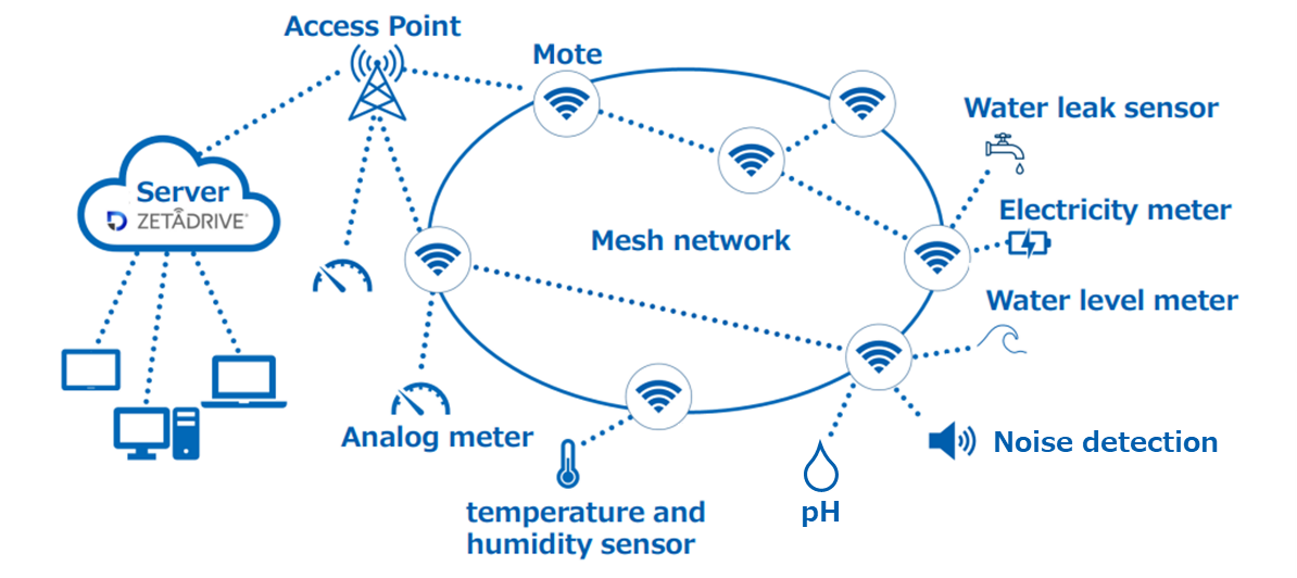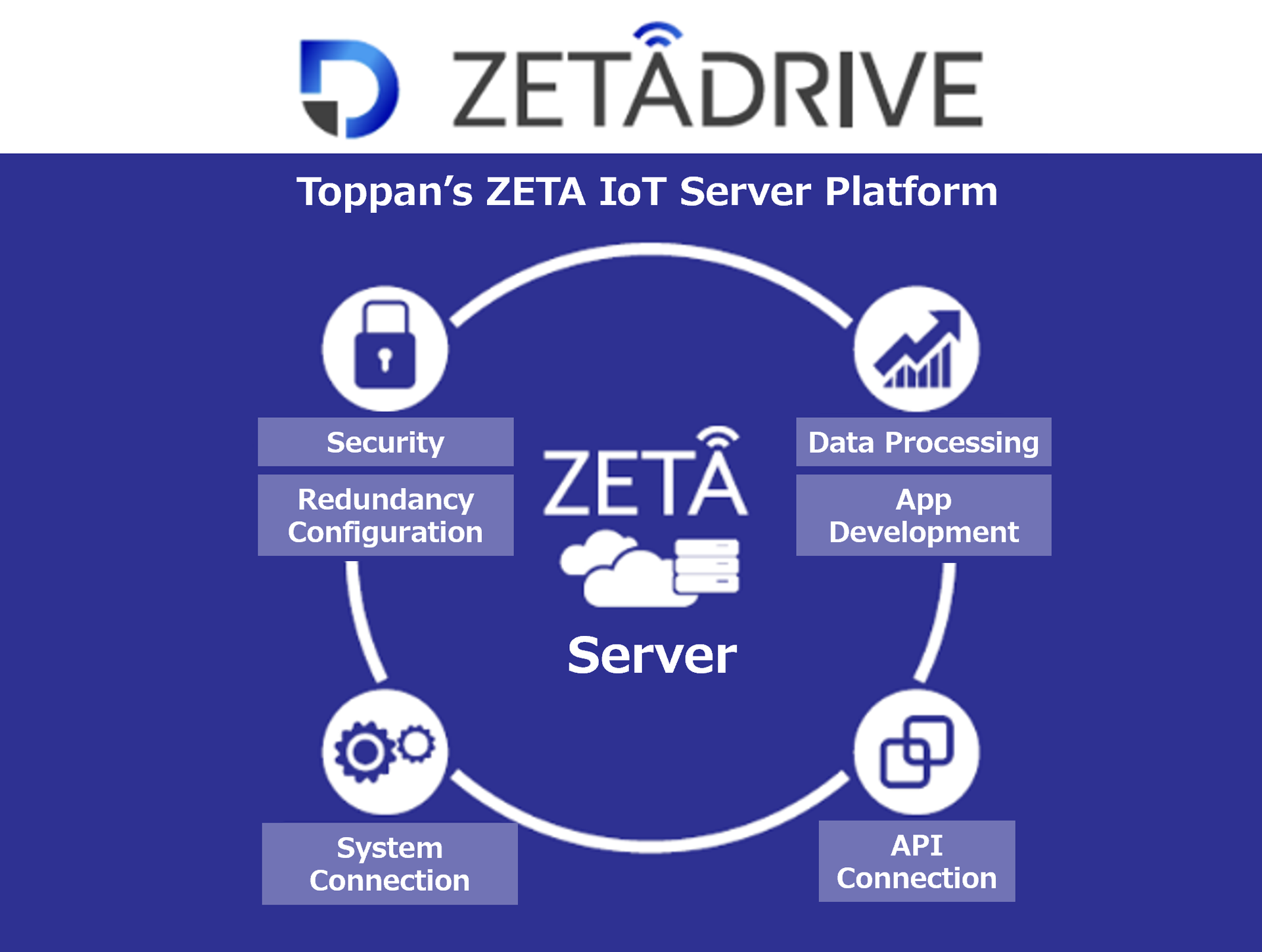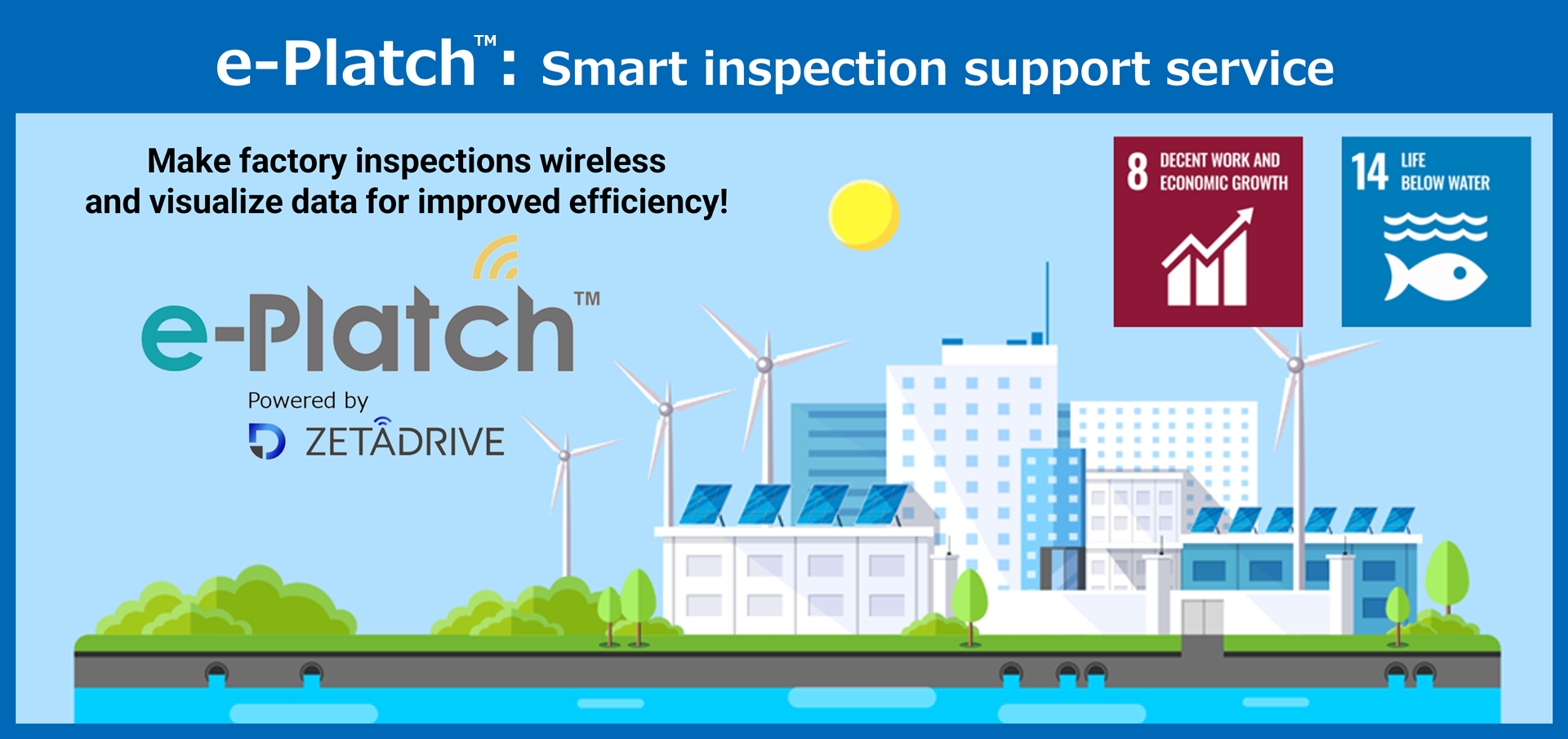ZETA: An IoT-oriented LPWAN standard
Achieve low-cost, fixed-point IoT data acquisition & monitoring.
TOPPAN provides total support from communication infrastructure construction to utilization.
ZETA is an LPWAN standard that achieves long-distance communication and low power consumption even in places where IoT communication can be challenging.
Integrated with TOPPAN’s comprehensive lineup of services, the effects of ZETA introduction are maximized.
For those considering the resolution of issues through IoT by utilizing LPWAN:
- Machine abnormality detection: Want to detect abnormalities in factory equipment by using vibration sensors.
- Smart agriculture: Want to increase productivity through the automatic management of cultivation conditions.
- Smart offices: Want to monitor remotely the temperature, humidity, lighting, and CO₂ concentration of the office.
- River water level monitoring systems: Want to issue automatic notifications regarding rises and falls in the water level.
- Location management: Want to track and manage the locations of things, vehicles, people, and animals.
TOPPAN's LPWAN service
LPWAN (Low Power Wide Area Network) refers to a system that can be used to achieve communication over a wide area while consuming little power. Due to the spread and development of IoT equipment in recent years, LPWAN technology has become extremely important for various businesses. TOPPAN provides solutions that help to resolve issues by utilizing these LPWAN. In addition to building network infrastructure, we can also provide support to overcome the issues that may follow.

ZETA: An LPWAN standard ideal for IoT communication
Developed by ZiFiSense Info Tech Co., Ltd., ZETA is a network standard like Wi-Fi and Bluetooth, and it belongs to the LPWAN (Low Power Wide Area Network) group. Unlike other LPWAN standards (LoRa, Sigfox, NB-IoT, etc.), ZETA enables multi-channel communication via UNB (ultra narrow band) technology, distributed access over a wide area via mesh networks, and low-power bi-directional communication, which makes it suitable for IoT. Given the current focus on smart cities and smart offices as well as the increasing prevalence of working from home, ZETA is starting to see use as a means of achieving remote operations and monitoring systems.
ZETADRIVE: A platform service that makes it easy to visualize and to manage complex data
ZETADRIVE is a platform service combined of servers required for ZETA networks and an app capable of visualizing data collected by ZETA. ZETA servers for device management are set up in the cloud by leveraging Toppan’s know-how regarding the development and operation of digital services, as well as its high-level security infrastructure. In addition, the sensor data browsing system can be used to handle everything comprehensively from gathering and managing data to visualizing it. Using APIs for functions like data acquisition and device control, systems and applications can also be integrated according to specific needs.

Why "ZETA" is suitable for IoT communication?
-
1
Low-power and reliable bidirectional communication
ZETA is capable of low-power bidirectional communication, with uplink transmission from the sensor and downlink reception from the server. It can also be used in the ultra-narrow band (UNB) of 2 kHz. It is resistant to radio interference and has high reliability.
-
2
Flexible expansion of network communication with multi-hop mesh network
Multi-hop mesh network can relay communications from distant sensors, expanding the communication area at low cost. Even if the connection to the access point is lost, communication can be maintained by detouring among several repeaters.
-
3
Easy data management and service integration by ZETADRIVE platform
Centralized management is possible through the ZETA communication platform "ZETADRIVE”. Everything from data collection and management to visualization is possible, and APIs allow integration with systems and applications tailored to your needs.
Price
The pricing consists of initial costs and running costs. The initial costs include equipment fees and a registration fee, while the running costs cover server and application usage fees.
* Additional charges may apply for communication verification and equipment installation.
Steps toward introduction
-
STEP 1:
Initial Consultation
We introduce our service and discuss the challenges you face.
-
STEP 2:
Site Assessment & Simulation
We investigate your site and conduct a Proof of Concept (PoC) simulation.
-
STEP 3:
Proof of Concept (PoC) Implementation
Upon your agreement, we implement the PoC and report the findings.
-
STEP 4:
Quotation & Equipment Proposal
Based on the simulation and PoC results, we provide a price estimate including suitable equipment.
-
STEP 5:
Contract Agreement
Upon your approval of the terms and conditions, including pricing, the contract is signed.
-
STEP 6:
System Installation
We install the necessary devices and application for service operation.
-
STEP 7:
Service Activation
You begin using the ZETA service.
Frequently
asked questions
-
QWhat are the differences compared to other LPWAN standards?
AWhile many other LPWAN are star-based, ZETA differs in that it uses a mesh access (multi-hop) topology. By relaying signals through repeaters (hops) to create a mesh-like wireless network, it's possible to build low-cost networks indoors, in urban areas, and even in remote mountainous regions.
-
QHow far can it communicate?
AThe communication range depends on the environment where it's installed, but in areas with good line of sight, it can communicate up to 10-20 km.
-
QHow long does the battery last?
ABattery life depends on the battery capacity and the frequency of data transmission, but it is expected to last for approximately 3 years.
-
QIs it mandatory to use the ZETA server? Please explain the benefits of using it.
AYes, if you choose to use ZETA, utilizing the ZETA server is required. The benefits of this include its high level of security, which ensures data safety. Additionally, it allows for immediate deployment without the need for customers to build an environment from scratch. Furthermore, it enables flexible system integration through APIs.
-
QAre there any restrictions on the service area?
AGenerally, no. However, the access point needs to be placed in an environment where it can connect to the internet.
-
QIs there a limit to the number of data transmissions?
ADue to the nature of LPWAN, we recommend a transmission frequency of about once per hour per sensor.
*Note: Regulations differ depending on the country, so we may be unable to conduct sales of this solution outside of Japan.

